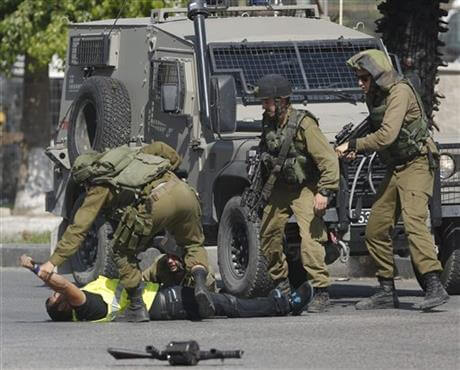
By NASSER SHIYOUKHI
A Palestinian man wearing a T-shirt with the word “press” written on it in large letters stabbed and wounded an Israeli soldier in the West Bank city of Hebron on Friday before being shot dead by troops, the latest in a monthlong spate of attacks.
The attack took place just meters from a clash between Palestinian stone-throwers and Israeli troops. An Associated Press photographer covering the clash saw the stabbing and then heard several gunshots. Soldiers rushed to the scene, administering aid to the injured soldier who was eventually taken away by ambulance.
The Foreign Press Association for Israel and the Palestinian territories said the attack was carried out by someone posing as a journalist and called on local Palestinian media organizations to verify all credentials.
In Nablus, another West Bank city, Palestinians firebombed a site revered by some Jews as the tomb of the biblical figure Joseph, an attack condemned as “irresponsible” by Palestinian President Mahmoud Abbas. Flames blackened exterior walls of the small stone structure, a scene of Israeli-Palestinian clashes in the past.
In the past month, eight Israelis were killed in Palestinian attacks, most of them stabbings. During the same period, 33 Palestinians were killed by Israeli fire — 15 labeled by Israel as attackers, and the others in clashes between stone-throwers and Israeli troops.
Many of the Palestinian assailants are from east Jerusalem, the sector of the city captured by Israel in 1967 and sought by the Palestinians as a future capital. The recent attacks have largely been carried out by individuals with no ties to militant groups. The violence comes at a time when a possible partition of the land between the Jordan River and the Mediterranean into two states — Palestine alongside Israel — is fading fast.
In response to the stabbings, Israel has taken unprecedented measures, including setting up checkpoints in Arab neighborhoods of Jerusalem this week despite Israel’s long-standing assertion that the city is united.
In one area, men passing through a checkpoint Friday said they lined up and ordered by troops to lift their hands and shirts to show they were unarmed before being allowed to pass.
Israel also imposed restrictions on Muslim worship at the Al-Aqsa Mosque compound, Islam’s third holiest site in Jerusalem’s walled Old City. Men under 40 were barred from the shrine, and hundreds of young worshippers spread out prayer mats on streets leading to the Old City.
The Muslim-run shrine, also revered by Jews as the holiest site of their religion, has been at the root of recent tensions. Palestinian and Muslim leaders have alleged Israel is attempting to change long-standing arrangements that bar Jews from praying on the hilltop compound, a claim denied by Israeli Prime Minister Benjamin Netanyahu. However, several senior members of Netanyahu’s coalition have called for Jewish prayer rights at the site, once home to biblical Jewish Temples.
The widespread perception among Palestinians that Al-Aqsa is under threat from Israel has fomented tensions and violence.
Abbas has tried to lower the temperature, telling his security commanders that armed attacks on Israelis counter Palestinian interests. However, he has also told his security forces not to stop Palestinian stone-throwers heading to confrontations with Israeli troops.
Abbas on Friday condemned the Nablus arson as “irresponsible,” ordered an investigation into who was behind it and said repairs would begin immediately, according to the official Palestinian news agency WAFA.
Dore Gold, a senior Israeli Foreign Ministry official, said the site was targeted “just because it is a place in which Jews pray.”
Lt. Col. Peter Lerner, an Israeli army spokesman, said the attack violates freedom of worship and that the military will “bring the perpetrators of this despicable act to justice.”
For centuries, the site has been identified with the biblical Joseph but some Palestinians say it was a sheikh’s grave or used as a mosque. The tomb has become a popular prayer site in recent years among some sects of religious Jews.
The site is located in an area under Palestinian self-rule and visits by Jews are coordinated between Palestinian security forces and Israeli troops.
___
Associated Press writer Mohammed Daraghmeh in Ramallah, West Bank contributed to this report.



